The nine urns of the Nguyen Dynasty were ordered cast by King Minh Mang in the winter of 1835 and completed on March 1, 1837. There were 9 big copper urns placed in front of The Mieu Temple yard (where Nguyen kings were worshipped) in Hue’s imperial citadel. Each urn signified a king of the Nguyen Dynasty and was named after the dead king. For example, Cao urn symbolising King Gia Long was named after Cao Hoang De, Nhan urn symbolising King Minh Mang was named after Nhan Hoang De.
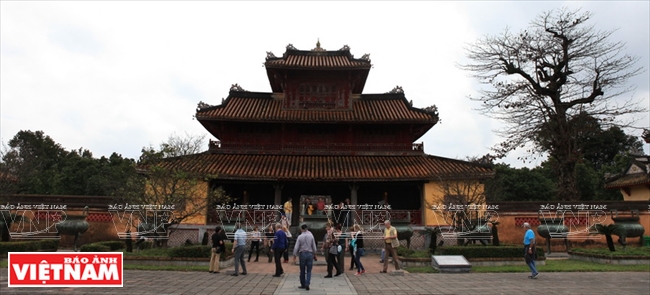 Nine dynastic urns are on the steps of Hien Lam Pavilion (in front of The Mieu Temple yard) in Hue imperial citadel. 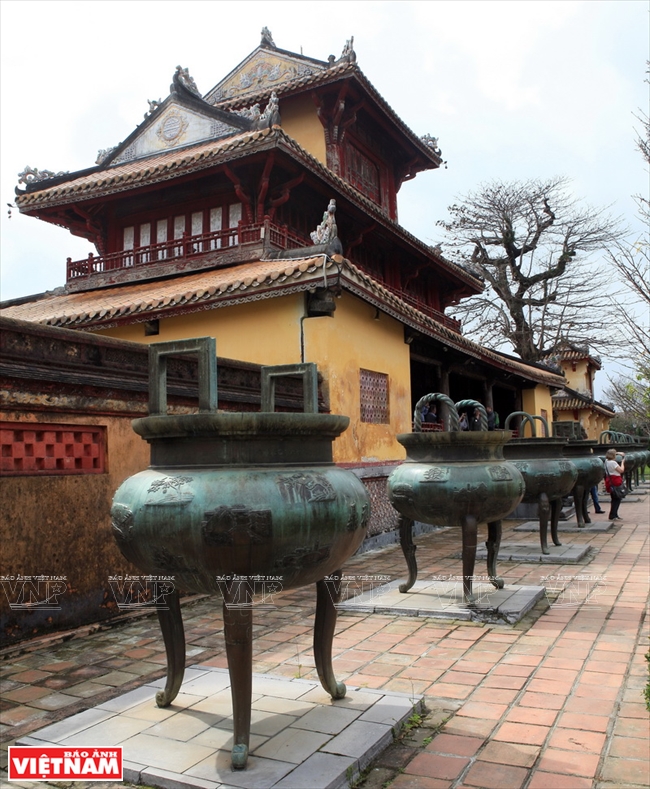 Nine dynastic urns were ordered cast by Kinh Minh Mang in the winter of 1835 and finished on 01/03/1837. 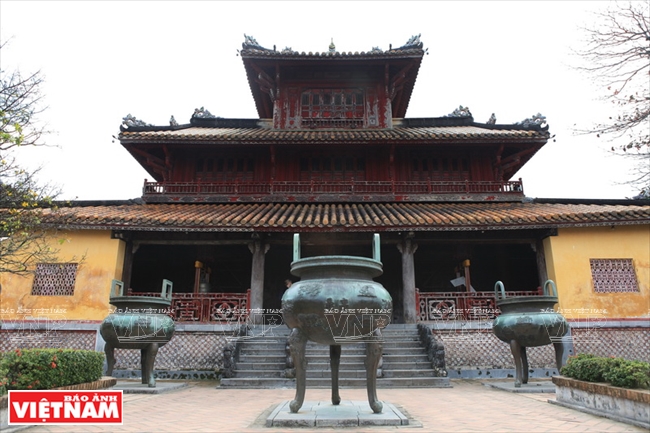 The urn in the very middle and higher than other urns is called Cao Urn. 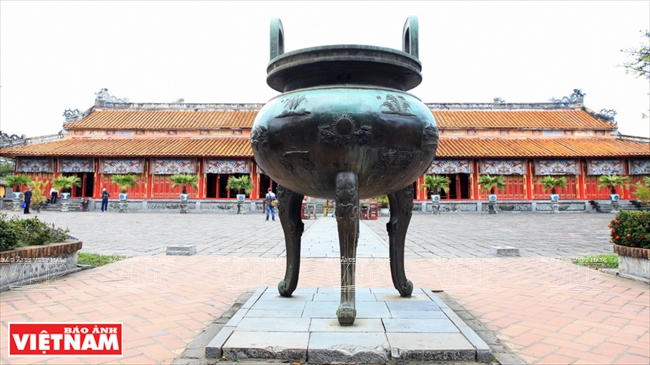 Cao Urn is placed higher than the other 8 urns to glorify the great merit of the first king of Nguyen Dynasty, Nguyen Anh, labeled Gia Long. 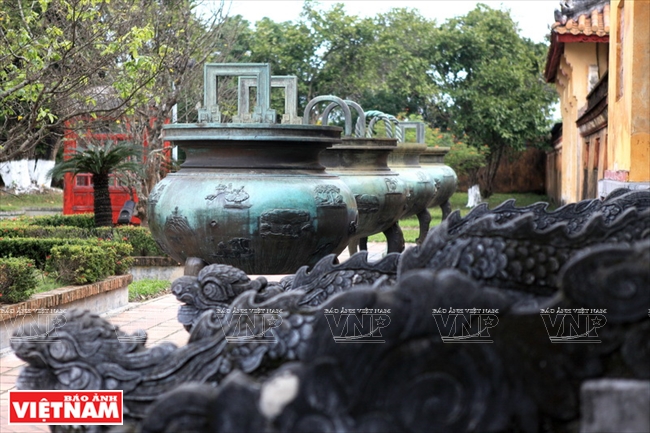 The 9 urns have different weights, legs as well as an upper handle with different carved images around each urn. 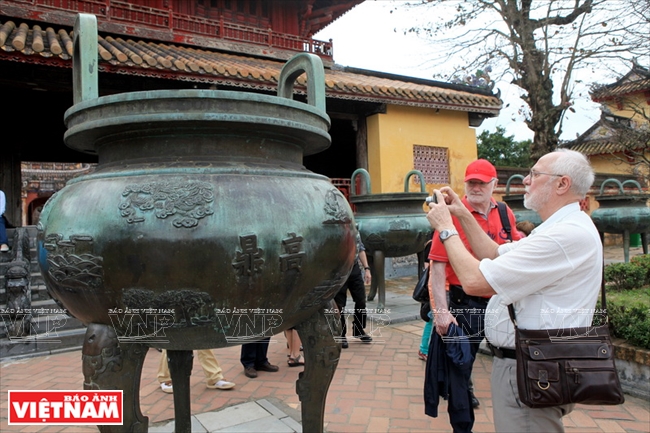 Tourists visit and take photographs of embossed patterns on nine dynastic urns. 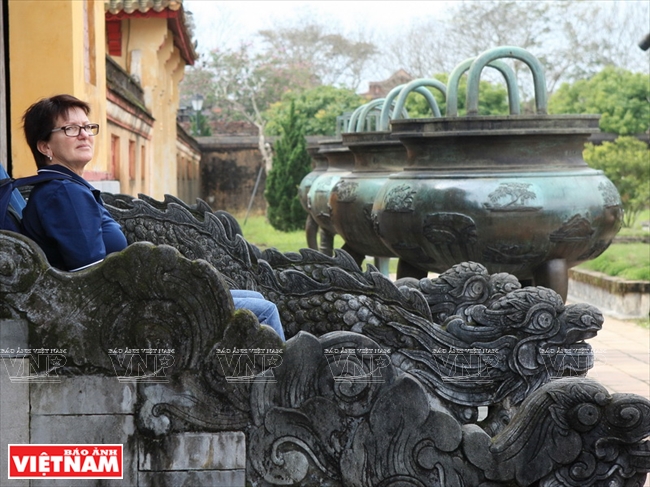 Tourists sit on the steps of Hien Lam Pavilion and look at the nine dynastic urns. |
The nine urns are placed in a horizontal row in front of Hien Lam Pavilion (a monument built to commemorate the Nguyen Dynasty within the Citadel of Hue), opposite The Mieu Temple. In particular, the Cao urn is placed on the main axis from Mieu Mon Temple via Hien Lam Pavilion to the middle chamber of The Mieu Temple where altars of King Gia Long are placed. The Cao urn is placed right in the middle of the nine urns and the only urn to be placed 3m forward to glorify the King who founded the Nguyen Dynasty.
On each urn, as ordered by Kinh Ming Mang, copper casting artisans in Phuc Ward in Hue carved 17 paintings and one calligraphy describing such topics as the universe, mountains and rivers, birds and animals, products and weapons. On the urns, there are 162 carved paintings which together create a panorama of unified Vietnam in the reign of the Nguyen Dynasty. For this reason, researchers argued that the nine urns are a geographical book, a carved encyclopedia on Vietnam at that time.
Each carved image is always accompanied by a very clear name. Therefore, when looking at the urns, though carved images are shown briefly and symbolically, we can learn the names of rivers, islands, trees, animals or places.
This is very easy to understand because before the urns were cast, King Minh Mang requested clearly: “It is not necessary to carve all the symbols of mountains, rivers and other things (i.e. simplified or simulating) but it is required to carve the name, code and origin for easy comment”.
As such, it can be seen that the origin and names of the carved images on the urns was highly appreciated by King Minh Mang. Therefore, this is very meaningful for later researchers.
According to Phan Thuan An, a researcher in Hue, the sovereignty image of Spratly and Paracel Islands of Vietnam was carved most clearly on the surface of the Cao urn with 3 images; the East Sea, marine boat (a kind of marine guard-boat of the infantry in the reign of King Gia Long) and a Trionychid turtle. In addition, on the Nhan urn, there is the carved image of the South Sea, a whale and a Hawk’s bill turtle. On the Chuong urn, there is the carved image of the West Sea, a dragon boat and a tortoise. On the Nghi urn and Thuan urn, there are carved images of the Thuan An estuary, the Da Nang estuary and Can Gio sea.
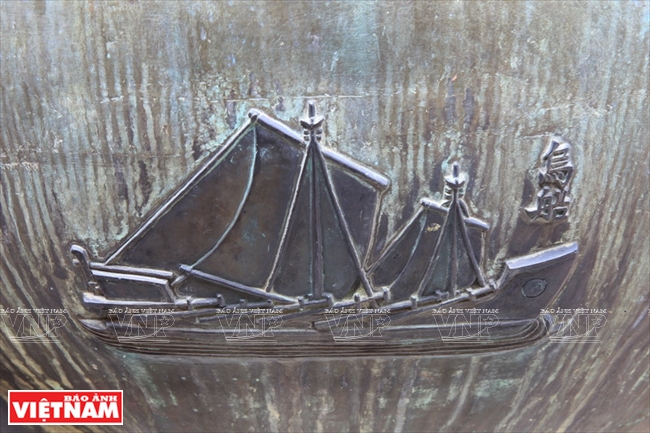 In the 17 year of Minh Mang, the king ordered a marine boat to be carved on the Du urn. During the reign of the preliminary Nguyen, this kind of boat was provided for military forces along the beach because it had a sail and a paddle, thus it could move very fast. 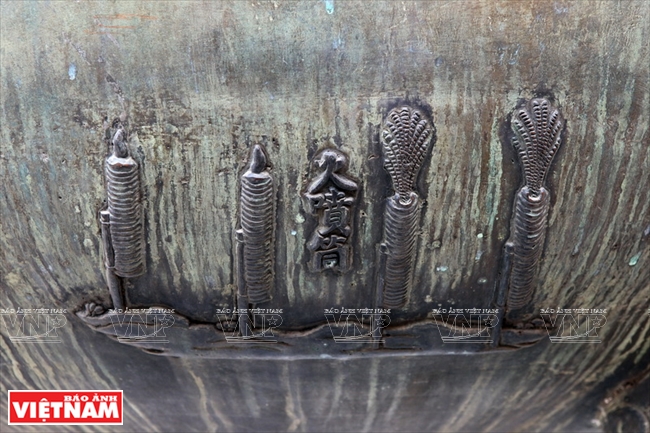 The symbol of a bullet firing copper tube carved on the Huyen urnThe symbol of a bullet firing copper tube carved on the Huyen urn. Hoa Phun Dong, a bullet firing copper tube or flame-throwing copper tube (fire command). This is a kind of “weapon” equipped for the army and provided to observatories on high mountains to transmit fire commands in an emergency, produced in the reign of Gia Long and Minh Mang. 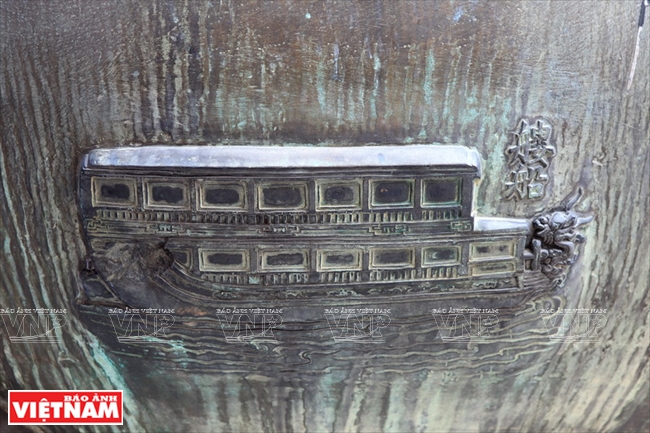 The symbol of a long boat on the Nhan urn. This is a big boat made from high quality wood, having with good decks (this is an outstanding achievement of Vietnam’s shipbuilding industry during the Nguyen Dynasty) made in the reign of King Gia Long and King Minh Mang. This boat is for the king, imperial family or escorting mandarins. 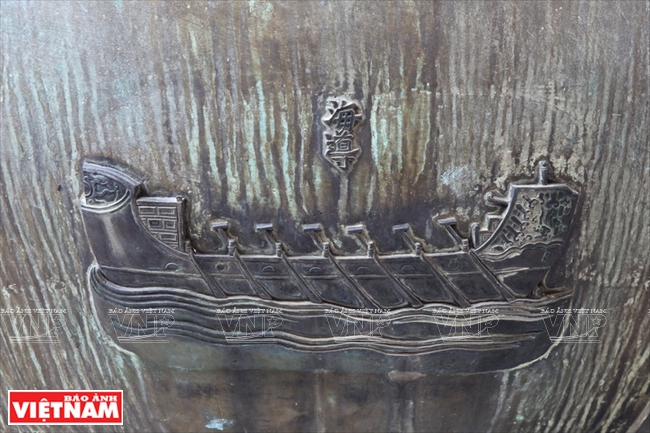 The symbol of a marine boat carved on the Nghi urn. Marine infantry of the Nguyen Dynasty used this kind of boat very well in fighting and maneuvering on water.  The symbol of a 12-paddle boat carved on the Tuyen urn. 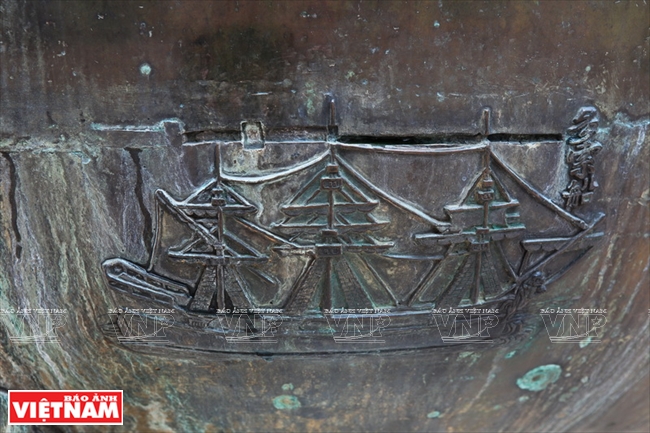 The symbol of a multitasking boat carved on the Cao urn. Because of its large size, it could be regarded as a ship with long-term seaworthiness or crossing the ocean. 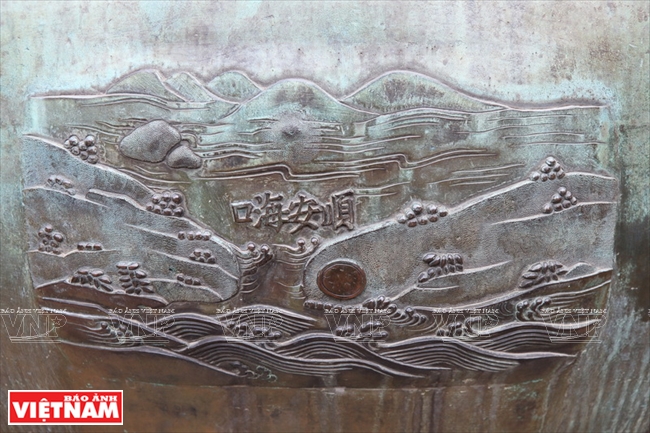 The symbol of the Can Gio estuary carved on the Thuan urn. This estuary had a strategic position in the economy and defense of southern Vietnam from the date of its founding. 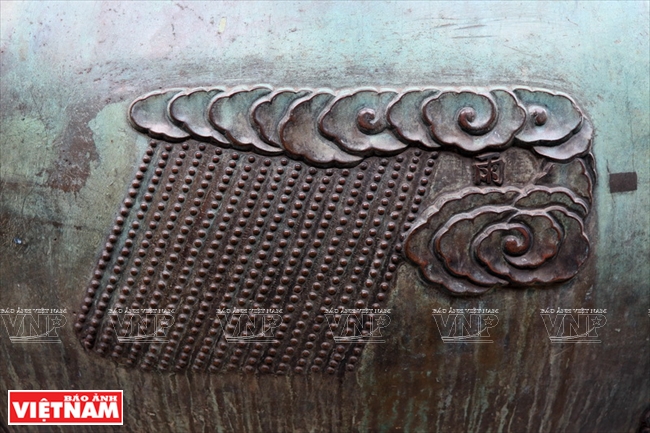 The symbol of plentiful rain carved on the Huyen urn. According to the Book of Changes, rain belongs to Kham lot, symbolising water. Rain is a climatic phenomenon, formed by a process where steam evaporates, condenses and then falls down. Rain creates the ecological balance and life of all species. 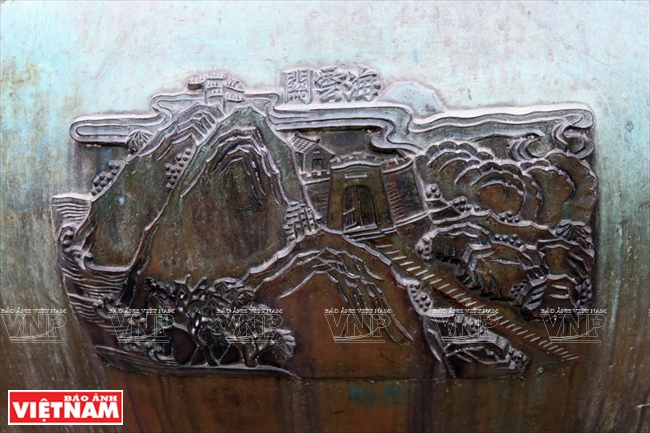 The image of Hai Van Mountain and Hai Van Frontier Passage on the Du urn. 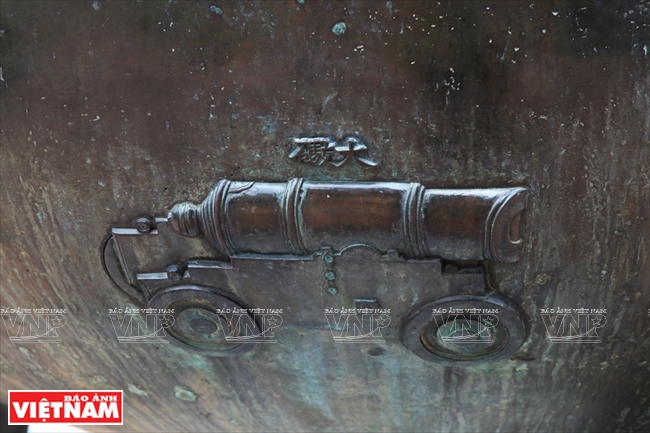 On the back of the Cao urn is the image of a cannon. 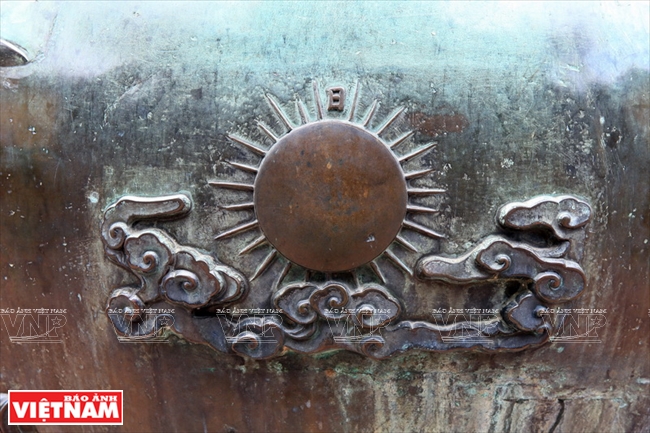 On the back of the Cao urn is the image of the sun. |
Through observations of the urns, we also realise that the carved images of the East Sea, South Sea and West Sea of Vietnam are shown as undulating waves, many islands of different sizes and many embossed Chinese characters showing the name of each sea clearly in the centre.
According to researchers, in the reign of King Minh Mang, the administrative boundary of localities and seas were determined very clearly in the state management decentralisation. Accordingly, the East Sea stretches from the North to Binh Thuan, including yellow sand, Spratly and Paracel, also known as Van Ly Ba Binh. The South Sea extends from Binh Thuan to Ha Tien with many islands such as Dai Kim, Manh Hao, Noi Truc, Con Dao, Phu Quoc and Tho Chau bordering the territorial waters of Malaysia and Indonesia. The West Sea is adjacent to the Gulf of Thailand.
As such, together with a wide range of ancient Han – Nom documents including the Vermilion Records of the Nguyen Dynasty, which was recognised by UNESCO as the World Documentary Heritage in Asia and the Pacific, the images of islands carved on the Nine dynastic urns will be a precious source of documents on the sovereignty of Vietnam towards Spratly and Paracel Islands.



